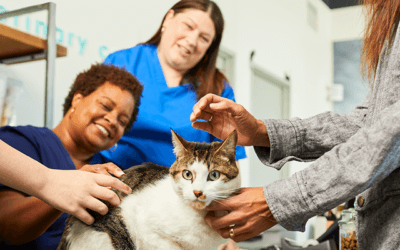Laboratory services and diagnostics represent a critical component of veterinary care, often providing a clinical roadmap to help rule out differentials and guide treatment. However, the operational workflows behind laboratory testing are frequently overlooked. These inadvertent inefficiencies can limit team productivity and risk profit margins the practice relies on.
Set your lab up for success
There isn’t a one-size-fits-all, go-to playbook for optimizing lab operational efficiency (yet!). Many practices have assembled lab testing procedures that work well enough for their teams, but consider what lab services might look like from an operational and fiscal perspective if they were carefully planned and managed?
Start-up practices have the benefit of skipping any troubleshooting and rebuilding phases, starting off with a strong, strategic approach. For established veterinary practices, consider these factors when evaluating and updating current workflows for lab testing.
How to optimize your laboratory services
1: Create standards of care
 Start by standardizing what tests are typically included in different case types. This might vary per doctor according to how they practice. Ideally, however, the entire doctor team agrees on what tests and analytes make up a “good” lab workup for a certain patient type. Creating—and communicating—this standard of care for lab testing reduces team headaches and communication time since the team automatically knows what sample types are needed, what tests to run or submit for, and what the standard bill should look like.
Start by standardizing what tests are typically included in different case types. This might vary per doctor according to how they practice. Ideally, however, the entire doctor team agrees on what tests and analytes make up a “good” lab workup for a certain patient type. Creating—and communicating—this standard of care for lab testing reduces team headaches and communication time since the team automatically knows what sample types are needed, what tests to run or submit for, and what the standard bill should look like.
Another bonus of creating standardized test panels is easier tracking of client compliance. Regularly opting for limited testing versus utilizing “normal” standardized testing may be revealing. A primary consideration may be client cost, followed by the need for a new, limited standard case workup, or improved client education.
2: Assemble SOPs for success
Once a practice chooses a set of standard workups, the next factor is defining the standard operating procedure (“SOP”). Most point-of-care lab equipment comes with protocols, some of which are flexible. Evaluate these protocols for the practice, modifying them if needed to produce accurate results that best fit the team. Sometimes performing testing in a particular order can save time.
The veterinary team must be able to trust the lab results, so creating and following SOPs eliminates one source of possible concern. Because not all technicians share the same level of interest or experience in lab testing, it is critical that the most important steps of the testing procedures are standardized and conveyed to the team.
SOPs could look like:
- Filling sample cups to a set level, ensuring adequate sample volume for all analytes
- Making heparinized plasma the standard sample for chemistry testing instead of waiting for RTT to clot and then pulling off serum
- Rocking the LTT (EDTA tube) for >1 minute prior to running a CBC instead of hand-mixing produces a more homogenous sample
3. Embrace technology
 A huge time sink in the lab can involve manually ordering or billing lab testing. Thankfully, many modern practice management systems (PIMS) are designed for bidirectional integration with lab equipment, saving time ordering and inputting results. Depending on the PIMS, lab billing can be somewhat automated by ordering “bundles,” where entering one line item automatically adds additional associated items to the bill. Bundle components are easily modified and confirmed.
A huge time sink in the lab can involve manually ordering or billing lab testing. Thankfully, many modern practice management systems (PIMS) are designed for bidirectional integration with lab equipment, saving time ordering and inputting results. Depending on the PIMS, lab billing can be somewhat automated by ordering “bundles,” where entering one line item automatically adds additional associated items to the bill. Bundle components are easily modified and confirmed.
Another technological advancement comes with apps designed for reporting lab results. Notably, Idexx offers their free app VetConnect Plus, which allows for real-time monitoring of patient results, both for point-of-care and reference laboratory testing. Historical results are available, plus the patient records are searchable, making for a semi-comprehensive lab work record at the team’s fingertips. All this integration allows for paper-free or paper-light lab workflows.
Beyond simple digital connections, some diagnostic platforms now incorporate AI with machine learning. Machine learning can identify cell types and areas of interest within samples, highlighting structures or cellular anomalies. This results in a faster, more standardized digital workflow. Beyond digitally analyzing the sample, some advanced platforms, such as digital cytology, virtually connect to diagnostic teams beyond the practice. Since most in-house diagnostics are a closed system in terms of the user interface, this remote collaboration allows for an expanded point-of-care capacity.
4: Establish communication channels
 Lab services require two separate communication channels: incoming lab requests and sharing of lab results. It’s worthwhile to standardize, minimalize, and automate both channels as much as possible, as these actions help protect the team from fatigue and prevent communication gaps.
Lab services require two separate communication channels: incoming lab requests and sharing of lab results. It’s worthwhile to standardize, minimalize, and automate both channels as much as possible, as these actions help protect the team from fatigue and prevent communication gaps.
Test ordering can be moved from paper to the practice PIMS or online by utilizing JotForm or similar form-building sites. These online forms are easily customized, allowing for flexible test selection. Accountability is heightened if required fields and electronic signatures are incorporated. Virtual submission forms create a digital paper trail that can be virtually managed, complete with custom tags such as “Submitted to Reference Lab.”
There’s no one best strategy or workflow for sharing lab results with the veterinary team. Paper results are bulky and inefficient; they can be replaced with dedicated channels within messaging apps like Slack, or simply within the PIMS.
Client communication workflows also vary across practices. Some practices prefer the veterinarian who ordered testing to share the results with the client, while other practices allow technicians to communicate results of less critical testing, such as fecal parasitology. Practices can also adopt a default communication strategy for high volume, low-risk testing such as wellness bloodwork panels where the veterinarian will only reach out to the client if test results are abnormal.
Make sure to consult state guidelines about permissible client communication (i.e., which level of the veterinary team is legally allowed to communicate results, etc.). No matter the communication method, managing client expectations by sharing what to expect following appointments is critical. Practices should consider contacting clients about normal results, as it promotes good client relationships.
5: Train your team
 Many practices rely on a team approach for performing in-house lab work, so it’s critical all team members responsible for lab work are comfortable with all common testing. Supported, regular and refresher cross-training for standard lab tests promotes staff proficiency and comfort with test procedures. Many veterinary staff members learn best by physically performing the testing themselves, so one-on-one training is ideal.
Many practices rely on a team approach for performing in-house lab work, so it’s critical all team members responsible for lab work are comfortable with all common testing. Supported, regular and refresher cross-training for standard lab tests promotes staff proficiency and comfort with test procedures. Many veterinary staff members learn best by physically performing the testing themselves, so one-on-one training is ideal.
The time invested in continued staff training will pay off handsomely in multiple ways: staff comfort in the lab produces trustworthy results quickly and greatly reduces the need to rerun testing.
6: Monitor financial components
 Strategically managing the fiscal aspects of lab services ensures a continuously strong contribution to the practice’s bottom line. Three main areas to continually monitor are lab test pricing, missed billing, and discounting tests.
Strategically managing the fiscal aspects of lab services ensures a continuously strong contribution to the practice’s bottom line. Three main areas to continually monitor are lab test pricing, missed billing, and discounting tests.
- Lab test pricing — Since setting and updating lab test pricing is specific to the individual practice, determining prices should not be formulaic (e.g., “2.5x list price,” etc.). Actual practice costs for testing supplies, equipment, and labor should be totaled, then the desired percentage or dollar amount relative to the type of practice added for a final client price. These pricing calculations should be reviewed regularly—ideally every six months—to keep up with rising supply costs.
- Missed billing — Back in 2013, AAHA estimated 17 percent of lab billing was left off the bill annually.1 It’s important to note missed billing bites in two ways: one, all supplies and labor costs were paid with no revenue to cover them, and two, all profit was missed. Thankfully, most modern PIMS have solved the bulk of missed billing-related events with bidirectional communication with laboratory equipment. However, depending on PIMS software and practice workflows, possible workarounds or situations exist when billing could still be missed. Identifying any areas of missed billing and then correcting associated workflows is always a great way to tighten up lab expenses.
- Discounting tests — It’s important to keep a watchful eye on discounts on lab testing since discounts always bite into profit. Sometimes discounts are too steep, resulting in the practice taking a financial loss for the testing. While it’s understandable that discounts can sometimes boost client compliance, leaning on them too heavily can inadvertently undermine the practice.a
Benefits of optimizing your laboratory services
1: Save time
Fully optimized daily operations give the veterinary team more margin in terms of time. This saved time allows the team to tackle other tasks, or creates room for more advanced programs related to the lab.
Here are a few pro-patient lab-related programs that could be offered:
- Early detection screens
- Wellness exams and bloodwork
- Advanced endocrinology testing
- Environmental surveillance for antimicrobial resistance (e.g., antimicrobial stewardship)
2: Boost revenue
Strengthening the lab’s foundation would likely also free up—and generate—revenue to support bringing in additional diagnostic tools, such as more advanced lab equipment and tests. This is also a great way to help the practice continue to offer cutting-edge diagnostics.
Bonus tip: A financially stable lab can also support career sustainability in veterinary medicine.
Strategically managing how the veterinary team handles lab-related procedures can save the team time and headaches. Focusing on improving operational efficiency is a great way to support the people of veterinary medicine. Taking an active role in managing lab services by refining the lab’s workflows and evaluating its contributions to the practice’s bottom line is not only good for business, but great for the team, patients, and clients.



